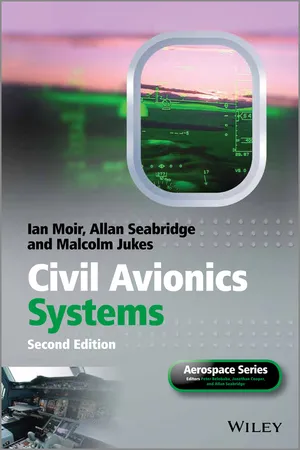
Civil Avionics Systems
- English
- ePUB (mobile friendly)
- Available on iOS & Android
Civil Avionics Systems
About this book
Civil Avionics Systems, Second Edition, is an updated and in-depth practical guide to integrated avionic systems as applied to civil aircraft and this new edition has been expanded to include the latest developments in modern avionics. It describes avionic systems and potential developments in the field to help educate students and practitioners in the process of designing, building and operating modern aircraft in the contemporary aviation system.
Integration is a predominant theme of this book, as aircraft systems are becoming more integrated and complex, but so is the economic, political and technical environment in which they operate.
Key features:
• Content is based on many years of practical industrial experience by the authors on a range of civil and military projects
• Generates an understanding of the integration and interconnectedness of systems in modern complex aircraft
• Updated contents in the light of latest applications
• Substantial new material has been included in the areas of avionics technology, software and system safety
The authors are all recognised experts in the field and between them have over 140 years' experience in the aircraft industry. Their direct and accessible style ensures that Civil Avionics Systems, Second Edition is a must-have guide to integrated avionic systems in modern aircraft for those in the aerospace industry and academia.
Frequently asked questions
- Essential is ideal for learners and professionals who enjoy exploring a wide range of subjects. Access the Essential Library with 800,000+ trusted titles and best-sellers across business, personal growth, and the humanities. Includes unlimited reading time and Standard Read Aloud voice.
- Complete: Perfect for advanced learners and researchers needing full, unrestricted access. Unlock 1.4M+ books across hundreds of subjects, including academic and specialized titles. The Complete Plan also includes advanced features like Premium Read Aloud and Research Assistant.
Please note we cannot support devices running on iOS 13 and Android 7 or earlier. Learn more about using the app.
Information
- The A380 and B787 aircraft have been introduced into service.
- The use of commercial off-the-shelf (COTS)-based data bus networks have significantly increased: in particular, ARINC 664 at the aircraft level, and CANbus at the intra-system level have been widely adopted.
- The introduction of advanced (3rd generation) IMA implementations on A380, B787 and emergent on A350.
- More-electric aircraft (MEA) implementations; in part on A380 and more extensively on B787.
- The rapid growth of global navigation satellite systems (GNSSs) in addition to GPS. The Russian GLONASS has been reconstituted in recent years, and COMPASS (China) and Galileo (European Union) systems are being established.
- The introduction of the electronic flight bag (EFB), most recently with iPad implementations by some organisations.
- The introduction of improved ground-based augmentation systems (GBAS)-based approaches.
- Significant improvements in flight deck displays using COTS glass in rectangular format. The trend towards larger display surfaces has continued, indeed escalated.
- Wider adoption of head-up displays and the use of enhanced vision systems (EVS) to help mitigate reduced visibility as a limiting factor in flight operations.
- The development of synthetic vision systems (SVSs) to provide an aid for location of runways and other objects.
| Implementation | Boeing approach | Airbus approach |
| IMA implementation (Chapter 6) | B777: First generation – AIMS/ELMS B787: Third generation using cabinets and supplier-furnished RIUs | A380: CPIOMs and subsystem supplier-furnished RDCs A350: CPIOMs and generic cRDCs |
| Onboard maintenance (Chapter 7) | Embedded maintenance display and PMAT options | Dedicated hardware in CMC |
| More-electric technology (Chapter 7) | B787: 500 kVA/channel at 230 VAC No bleed air off-take from engine. Electric ECS, engine starting and anti-icing | A380: 150 kVA/channel at 115 VAC 2 ‘H’ + 2 ‘E’ architecture – blue hydraulics channel subsumed into electrical implementation Use of EBHAs |
| Data bus wiring (Chapter 7) | Twinax wiring | Quadrax wiring |
| Aircraft wiring (Chapter 7) | Not < 22 AWG | Not < 24 AWG |
| Fly-by-wire (Chapter 10) | Conventional control yoke for pitch and roll inputs Trio-triplex computing using dissimilar hardware Similar software | Sidestick controller for pitch and roll inputs Multiple dual COM/MON computing Dissimilar hardware and software |
| Electronic flight bag (Chapter 11) | Class I/Class II Fixed or docked | Class III Laptop/iPad/Tablet |
| FANS embodiment (Chapter 11) | [B737;B747;B757;B767;B777] Fixed hardware with software upgrades/increments | Additional hardware: ATSU/DCDU |
- Enabling technologies and techniques (1.3.1).
- Functional avionics systems (1.3.2).
- The flight deck (1.3.3).

- Chapter 2 – Avionics Technology
- Chapter 3 – Data Bus Networks
- Chapter 4 – System Safety
- Chapter 5 – Avionics Architectures
- Chapter 6 – Development Processes.
- Chapter 7 – Electrical Systems and Installation
- Chapter 8 – Sensors
- Chapter 9 – Communications and Navigation Aids
- Chapter 10 – Flight Control Systems
- Chapter 11 – Navigation Systems and PBN
- Chapter 13 – Military Aircraft Adaptations.
- Chapter 12 – Flight Deck Displays.
- Appendix A: Safety Analysis – Flight Control System
- Appendix B: Safety...
Table of contents
- Cover
- Aerospace Series List
- Title Page
- Copyright
- Dedication
- About the Authors
- Series Preface
- Preface to Second Edition
- Preface to First Edition
- Acknowledgements
- List of Abbreviations
- Chapter 1: Introduction
- Chapter 2: Avionics Technology
- Chapter 3: Data Bus Networks
- Chapter 4: System Safety
- Chapter 5: Avionics Architectures
- Chapter 6: Systems Development
- Chapter 7: Electrical Systems
- Chapter 8: Sensors
- Chapter 9: Communications and Navigation Aids
- Chapter 10: Flight Control Systems
- Chapter 11: Navigation Systems
- Chapter 12: Flight Deck Displays
- Chapter 13: Military Aircraft Adaptations
- Appendices
- Index